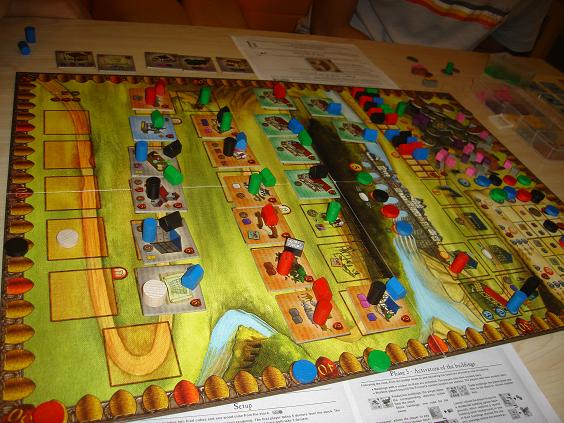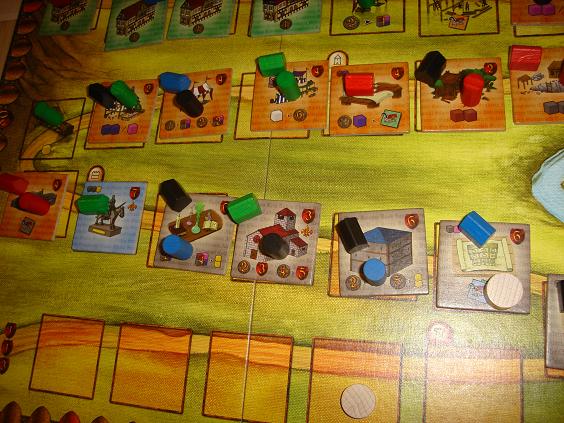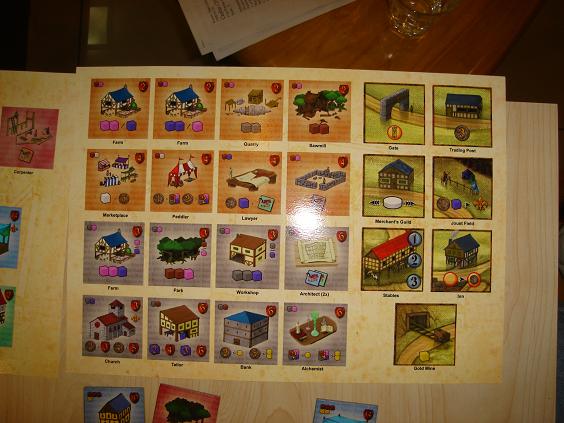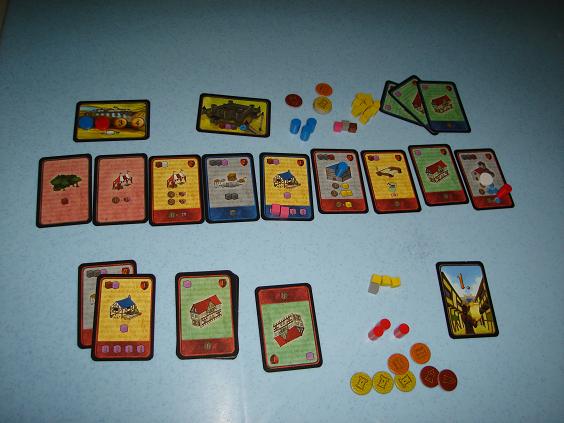Caylus is another one of those economic games that are ranked very highly on BGG and that I knew I’d just have to play someday. Caylus: Magna Carta is the card-based version that Han donated as a prize for the recent mini-tourney at CarcaSean. Since they are so similar, it only makes sense to cover both of them in the same post. We first played Caylus at CarcaSean. I didn’t know in advance that we’d be playing this game and didn’t prepare so I was quite bewildered at first by the board with the innumerable little elements on it and the profusion of building tiles.
Since my wife and I are both very familiar with Agricola, it probably helped us to think of it as a similar sort of worker placement game. There are tons of differences of course. In Caylus, the only limits to placing workers are how much money you have and what open spaces are left on the board and while placing a worker in Agricola allows you to execute the associated action immediately, in this game the action is resolved in the next phase in a fixed order and might not even take place at all depending on whether or the other players are willing to pay money to frustrate you!
The other thing that makes this game hard to learn is that every building tile in the pool is always available. You still need to place a worker on the prerequisite construction building on the board and the required materials on hand of course, but in theory you could walk into the game with a predefined plan for which particular buildings you’re aiming for and base. Since there are many buildings with quite specific and interesting effects, it’s obvious that you need to really know them all well to plan your strategy properly.
That said, Chong Sean clearly had a better idea what he was aiming to do in the game, including showing off some tricks that he read about in BGG, but I still ended up winning the game anyway even though I was just muddling around and placing my workers on whatever looked most immediately advantageous without any long-term plan in mind. I think that this was partly because I was copying Sean in choosing what royal favors to take and the other players were determined not to let Sean win, but I don’t think it would be possible to do well at Agricola if you didn’t have a plan.
I can see that there are more scoring options in Caylus, so there many more directions in which you can develop to get your points. This means that even though this game is more directly confrontational than other Eurogames I’ve played because you can spend money to screw another player, you should be able to reassess your priorities if your original plan is blocked and go somewhere else for points. You also don’t get the punitive penalties of Agricola which I think lessens the tension.
Overall I think that this is good economic game that I’d like to play from time to time and I can see it having plenty of replay value as you’ll probably need to have quite a few games under your belt before you can work out an optimal build order for the buildings. I still think Agricola is distinctly better. Agricola at least is decent with just two players but I can’t really see Caylus as being any good with just two. As a side note, Sean showed us the collector’s edition of the game afterward. While the coins and moneybag do indeed look nice, I think that the other version of the board looks very ugly and non-functional due to lots of wasted space on it.
One thing I realized while playing this is that I quite like knowing what the different names of the buildings are, for example that it is the Tailor building that converts dye to cash and it is the Bank building that converts cash to gold. It’s just a light bit of theme but I find it helps me understand and visualize what the buildings do more intuitively while Chong Sean doesn’t seem to care about that stuff and is able to process the information more abstractly. I even enjoy knowing that the little counter is called the Provost while the piece it follows around is called the Bailiff.
Anyway playing Caylus inspired us to get around to playing the card-based version donated by Han. It turns out that the differences are pretty minor. The main thing is that you can only construct the building if you have the card for it in your hand and there are no choices on what royal favor to get if you’re the player who contributes the most towards completing the castle. You just get a gold token instead. Plus you don’t need a construction building to build something. You just play the appropriate card and pay its resource cost.
The game comes with very little stuff actually as cards are used to create an abstracted version of the Caylus board and one type of resource, dye, has been eliminated. This means that the only contents of the box are the cards, the wooden bits for the resources and the various counters for money, Victory Points etc. This makes the full-sized box look a bit silly as it would have been easy to pack everything into a box half the size with space to spare.
In our game my wife focused on making lots of buildings while I focused on grabbing lots of gold and won by a significant margin. The thing about playing this with only two players is that seeing who’s going to contribute resources towards castle construction is too predictable. Naturally the person who is erecting buildings won’t be contributing goods while the other person, seeing that there’s no competition, will always contribute goods for the guaranteed gold. I’m sure that things would be more dynamic with just one additional player, but at two persons, it’s just kind of stale.
Anything thing I noticed is that with a real board, the Provost can move ahead of the buildings that have been placed, sometimes by a fair distance. In Caylus: Magna Carta, the Provost is limited to just the cards. This makes it dangerous for a player to place a worker on the cards at the end of the road as the other player could easily pay for the Provost to backtrack a bit. In my case at least, it also reduced the incentive to construct buildings but perhaps this is something else that would work better with more players.
The one thing I do like about Magna Carta is that the special benefit that building owners get when another player uses their building varies according to the card. This means that when another player uses my farm to get food, I can get food for free and that when another player uses one of my buildings to spend cash to buy resources, I can spend some money to buy a resource as well. In the original, you just get one Victory Point whenever another player uses your building, even if it’s a super expensive one. That’s kind of boring. In this version, if you’re clever enough you can even time it so that the building owner won’t have the leverage to capitalize on its special benefit when your worker uses it. That’s fun.
Still, that’s not enough to overcome the fact that Magna Carta feels like a lighter version of the original and I can’t imagine that anyone who like economic games would feel intimidated by Caylus. The only reason I can think of to prefer the card-based version is its portability, otherwise if it were up to me, I’d just stick with the original. Plus while making the road out of cards is a neat idea, having the real road on a nice looking board is much more appealing to me.




Leave a Reply